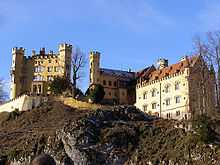Hohenschwangau Castle


Hohenschwangau Castle or Schloss Hohenschwangau (lit: High Swan County Palace) is a 19th-century palace in southern Germany. It was the childhood residence of King Ludwig II of Bavaria and was built by his father, King Maximilian II of Bavaria. It is located in the German village of Hohenschwangau near the town of Füssen, part of the county of Ostallgäu in southwestern Bavaria, Germany, very close to the border with Austria.
History
Hohenschwangau Castle was built on the remains of the fortress Schuangau, which was first mentioned in historical records dating from the 12th Century. A family of knights was responsible for the construction of the medieval fortress, and it served as the seat of the local government of Schwangau. In 1523, the schloss was described as having walls which were too thin to be useful for defensive purposes. After the demise of the knights in the 16th Century, the fortress changed hands several times. The decay of the fortress continued until it finally fell into ruins at the beginning of the 19th Century.
In April 1829, Crown Prince Maximilian (the later King Maximilian II of Bavaria) discovered the historic site during a walking tour and reacted enthusiastically to the beauty of the surrounding area. He acquired the ruins - then still known as Schwanstein - in 1832. In February 1833, the reconstruction of the Castle began, continuing until 1837, with additions up to 1855. The architect in charge, Domenico Quaglio, was responsible for the neogothic style of the exterior design. He died in 1837 and the task was continued by Joseph Daniel Ohlmüller (died 1839) and Georg Friedrich Ziebland.[1] Queen Marie created an alpine garden with plants gathered from all over the alps.
Hohenschwangau was the official summer and hunting residence of Maximilian, his wife Marie of Prussia, and their two sons Ludwig (the later King Ludwig II of Bavaria) and Otto (the later King Otto I of Bavaria). The young princes spent many years of their adolescence here. The King and the Queen lived in the main building, and the boys in the annex.

King Maximilian died in 1864 and his son Ludwig succeeded to the throne, moving into his father's room in the castle. As Ludwig never married, his mother Marie was able to continue living on her floor. King Ludwig enjoyed living in Hohenschwangau, especially after 1869 when the building of his own castle, Neuschwanstein, began only a stone's throw from his parental home.

After Ludwig's death in 1886, Queen Marie was the castle's only resident until she in turn died in 1889. Her brother-in-law, Prince Regent Luitpold of Bavaria, lived on the 3rd floor of the main building. He was responsible for the electrification in 1905 and the installation of an electric elevator. Luitpold died in 1912 and the palace was opened as a museum during the following year.
During World War I and World War II, the castle suffered no damage. In 1923, the Bavarian Landtag recognised the right of the former royal family to reside in the castle. From 1933 to 1939, Crown Prince Rupprecht of Bavaria and his family used the castle as their summer residence, and it continues to be a favourite residence of his successors, currently his grandson Franz, Duke of Bavaria. In May 1941, Prince Adalbert of Bavaria was purged from the military under Hitler's Prinzenerlass and withdrew to the family castle Hohenschwangau, where he lived for the rest of the war.
More than 300,000 visitors from all over the world visit the palace each year. The castle is open all through the year (except for Christmas). Opening hours are 9 a.m. to 6 p.m. (April through September) and 10 a.m. to 4 p.m. (October through March). Guided tours are provided in German, English, French, Italian, Spanish, Russian, Czech, Slovenian, and Japanese. Self-guided tours are not available.
References
- ↑ Hans F. Nöhbauer: Auf den Spuren König Ludwigs II. (München, Prestel Verlag, 3. Aufl. 2007) S. 81ff.
External links
| Wikimedia Commons has media related to Schloss Hohenschwangau. |
- Official homepage (in English)
- Information for tourists
- Ticket information
- Extensive Photo Gallery of Hohenschwangau
| ||||||||
Coordinates: 47°33′20″N 10°44′10″E / 47.55556°N 10.73611°E